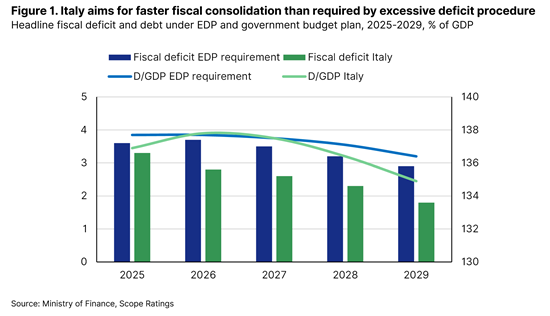Announcements
Drinks

Italy: fiscal consolidation on track but high debt, structural weaknesses persist
By Eiko Sievert and Alessandra Poli, Sovereign and Public Sector
Italy (BBB+/Stable) has unveiled its new fiscal structural plan aiming to reduce its fiscal deficit targets and place its debt-to-GDP on a downward path from 2027. The proposed fiscal tightening hinges on a combination of higher fiscal revenues and targeted spending cuts, a gradual phasing out of a home renovation tax credit (the Superbonus scheme) and measures to combat tax evasion.
This strategy aims to help Italy exit the Excessive Deficit Procedure (EDP) by 2026, lowering the deficit below the threshold of 3% of GDP. The plan also seeks to maintain compliance with European fiscal rules in the longer term. The fiscal consolidation effort coincides with Italy’s economic growth showing signs of weakening after downward revisions for the first six months of 2024.
Despite the government’s commitment to fiscal discipline, significant improvements in Italy's debt trajectory remain elusive. The debt-to-GDP ratio remains on an upward path, set to increase slightly from 134.8% in 2023 to peak at 137.8% in 2026, despite the ambitious targets to reduce the general government deficit. Rising debt-to-GDP reflects the impact of the costly Superbonus tax credit introduced during the pandemic, whose cumulative impact on the public debt will amount to around 6% of GDP between 2024 and 2027. The government expects debt-to-GDP at 134.9% in 2029, unchanged from 2023 and in line with elevated pre-pandemic levels. Italy’s public finances will therefore continue to be vulnerable to external shocks in the medium term.
A more favourable starting point ahead of fiscal consolidation
Revised statistics published in September show that recent economic growth was stronger than estimated while public debt stood at 134.8% of GDP in 2023 compared with a previous estimate of 137.3%. Official forecasts for the 2024 fiscal deficit were lowered to 3.8% from 4.4% of GDP.
The improved position at the start of the EDP allows for a minimum average annual adjustment of the structural primary balance of 0.5pps of GDP over 2025-2031, as well as an average annual increase of net primary expenditure of 1.9%. This compares with more stringent initial estimates by the European Commission of 0.6pps and 1.5% respectively. Adhering to this path of fiscal adjustment would allow Italy to exit from the EDP in 2029 when the fiscal deficit would fall below 3%.
The government’s medium-term budget plans include a faster fiscal consolidation, targeting an exit from the EDP by 2026. Achieving this will depend largely on how successfully reforms improve the effectiveness of public spending, reduce tax evasion and boost employment and income tax. The phasing out of the Superbonus should help to reduce public debt-to-GDP from 2027 if continued primary fiscal surpluses offset the high cost of servicing Italy’s public debt.
Growth potential dependent on EU support , challenging demographics
We expect the Italian economy to grow by around 1% per year, in line with the government’s medium-term structural budget plan. Growth over the coming years will be supported by a recovery in private consumption and rising exports. In the construction sector, strong order backlogs and higher spending from the implementation of the National Recovery and Resilience Plan (NRRP) should largely offset the declining stimulus from the Superbonus scheme.
Italy's ability to deploy funds from the NRRP and the EU’s Cohesion Policy effectively and without delays will be crucial in determining the country's future growth. Under the NRRP, the country has so far received EUR 113.5bn out of an allocated EUR 194.4bn (around 9% of GDP in 2023), but only about EUR 52bn has been spent to date. Similarly, out of EUR 129bn in cohesion funds for 2014-2020 (since extended due to the pandemic), less than a fifth of more than a million projects have been completed to date.
The budget plan indicates that investments as a share of GDP will remain above pre-pandemic levels after the end of the NRRP in 2026. We expect that the government will implement reforms agreed in the NRRP, and that the allocated funds will be spent on time, though the impact of these reforms on Italy’s long term growth potential remains uncertain.
Nevertheless, structural pressures continue to weigh on Italy’s future growth prospects. Despite recent improvements in the labour market, the employment rate of 66.8% remains well below the euro area average of 75.4%. Participation is particularly weak among women. With most employment concentrated in small and medium-sized enterprises, Italy’s real labour productivity per hour worked increased by 0.1% a year on average between 2014 and 2023, below the EU average of 0.8%.
Finally, the country’s working age population is set to decline by almost 19% between 2023 and 2040 – the biggest reduction in Europe – outpacing reductions expected in Germany, Spain (both at 14%) and France (2%), underlining the growing importance of labour market reforms for Italy’s long term economic prospects.
Stay up to date with Scope’s ratings and research by signing up to our newsletters across credit, ESG and funds. Click here to register.






